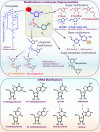RNA-based therapies: A cog in the wheel of lung cancer defense
- PMID: 33740988
- PMCID: PMC7977189
- DOI: 10.1186/s12943-021-01338-2
RNA-based therapies: A cog in the wheel of lung cancer defense
Abstract
Lung cancer (LC) is a heterogeneous disease consisting mainly of two subtypes, non-small cell lung cancer (NSCLC) and small cell lung cancer (SCLC), and remains the leading cause of death worldwide. Despite recent advances in therapies, the overall 5-year survival rate of LC remains less than 20%. The efficacy of current therapeutic approaches is compromised by inherent or acquired drug-resistance and severe off-target effects. Therefore, the identification and development of innovative and effective therapeutic approaches are critically desired for LC. The development of RNA-mediated gene inhibition technologies was a turning point in the field of RNA biology. The critical regulatory role of different RNAs in multiple cancer pathways makes them a rich source of targets and innovative tools for developing anticancer therapies. The identification of antisense sequences, short interfering RNAs (siRNAs), microRNAs (miRNAs or miRs), anti-miRs, and mRNA-based platforms holds great promise in preclinical and early clinical evaluation against LC. In the last decade, RNA-based therapies have substantially expanded and tested in clinical trials for multiple malignancies, including LC. This article describes the current understanding of various aspects of RNA-based therapeutics, including modern platforms, modifications, and combinations with chemo-/immunotherapies that have translational potential for LC therapies.
Keywords: Antisense oligonucleotides; Lung cancer; RNA interference; anti-miRs; mRNA-vaccine.
Conflict of interest statement
SKB is co-founder of Sanguine Diagnostics and Therapeutics, Inc. AKG is on the advisory board for Blueprint Medicines, Cardinal Health, AstraZeneca, and G1 Therapeutics. He has served as a consultant to AstraZeneca and Genentech, and received research support from Oncoceutics and Takeda Pharmaceuticals. Other authors declare no competing interests.
Figures




Similar articles
-
Non-Viral RNA Therapies for Non-Small Cell Lung Cancer and Their Corresponding Clinical Trials.Mol Pharm. 2025 Apr 7;22(4):1752-1774. doi: 10.1021/acs.molpharmaceut.4c00871. Epub 2025 Mar 25. Mol Pharm. 2025. PMID: 40131145 Review.
-
MicroRNAs in non-small cell lung cancer: Gene regulation, impact on cancer cellular processes, and therapeutic potential.Pharmacol Res Perspect. 2019 Dec;7(6):e00528. doi: 10.1002/prp2.528. Pharmacol Res Perspect. 2019. PMID: 31859460 Free PMC article. Review.
-
Small RNAs and non-small cell lung cancer.Curr Mol Med. 2006 May;6(3):339-49. doi: 10.2174/156652406776894554. Curr Mol Med. 2006. PMID: 16712479 Review.
-
A review on RNAi therapy for NSCLC: Opportunities and challenges.Wiley Interdiscip Rev Nanomed Nanobiotechnol. 2021 Mar;13(2):e1677. doi: 10.1002/wnan.1677. Epub 2020 Nov 10. Wiley Interdiscip Rev Nanomed Nanobiotechnol. 2021. PMID: 33174364 Review.
-
Recent Advances and Prospects in RNA Drug Development.Int J Mol Sci. 2024 Nov 15;25(22):12284. doi: 10.3390/ijms252212284. Int J Mol Sci. 2024. PMID: 39596348 Free PMC article. Review.
Cited by
-
A novel tubulin inhibitor, 6h, suppresses tumor-associated angiogenesis and shows potent antitumor activity against non-small cell lung cancers.J Biol Chem. 2022 Jul;298(7):102063. doi: 10.1016/j.jbc.2022.102063. Epub 2022 May 23. J Biol Chem. 2022. PMID: 35618020 Free PMC article.
-
Fibroblasts activated by miRs-185-5p, miR-652-5p, and miR-1246 shape the tumor microenvironment in triple-negative breast cancer via PATZ1 downregulation.Cell Mol Life Sci. 2025 Jul 25;82(1):287. doi: 10.1007/s00018-025-05781-y. Cell Mol Life Sci. 2025. PMID: 40711489 Free PMC article.
-
Applications and advancements of nanoparticle-based drug delivery in alleviating lung cancer and chronic obstructive pulmonary disease.Naunyn Schmiedebergs Arch Pharmacol. 2024 May;397(5):2793-2833. doi: 10.1007/s00210-023-02830-w. Epub 2023 Nov 22. Naunyn Schmiedebergs Arch Pharmacol. 2024. PMID: 37991539 Review.
-
Gankyrin modulated non-small cell lung cancer progression via glycolysis metabolism in a YAP1-dependent manner.Cell Death Discov. 2022 Jul 9;8(1):312. doi: 10.1038/s41420-022-01104-3. Cell Death Discov. 2022. PMID: 35810157 Free PMC article.
-
A Strategy Utilizing Protein-Protein Interaction Hubs for the Treatment of Cancer Diseases.Int J Mol Sci. 2023 Nov 8;24(22):16098. doi: 10.3390/ijms242216098. Int J Mol Sci. 2023. PMID: 38003288 Free PMC article. Review.
References
Publication types
MeSH terms
Substances
Grants and funding
LinkOut - more resources
Full Text Sources
Other Literature Sources
Medical

